Conceptual Overview
Overview
DREAM3D-NX uses an abstract, hierarchical data structure that has roots in the concepts of combinatorial topology and common methods for describing mesh structures. The generalized data structure follows a tree structure with the following possible node types:
DataStructure: The top level object that holds a tree of DataObjects.
DataGroup: This DataObject can hold 1 or more DataObjects
AttributeMatrix: This is a special kind of DataObject that only holds DataArray objects where all DataArray objects must have the same number of Tuples. The AttributeMatrix is an exact corollary to the original AttributeMatrix from the previous version of DREAM3D-NX
Geometry: This is another special DataGroup that represents any one of the geometric meshes that are supported in DREAM3D-NX. The supported geometric meshes are the following:
ImageData:
Rectilinear Grid:
Vertex
Edge
Triangle
Quad
Hexahedron
Tetrahedral
DataArray: This DataObject holds the actual raw data values that are used within DREAM3D-NX. This can be anything from simple gray scale image data to multidimensional data. DREAM3D-NX utilizes a flat data storage approach, such that even multidimensional data is allocated into a contiguous section of memory. This approach enables faster and more efficient compute times.
For most DREAM3D-NX functions, the user is given control over how to name the various objects within the Data Structure tree with most filters providing reasonable defaults.
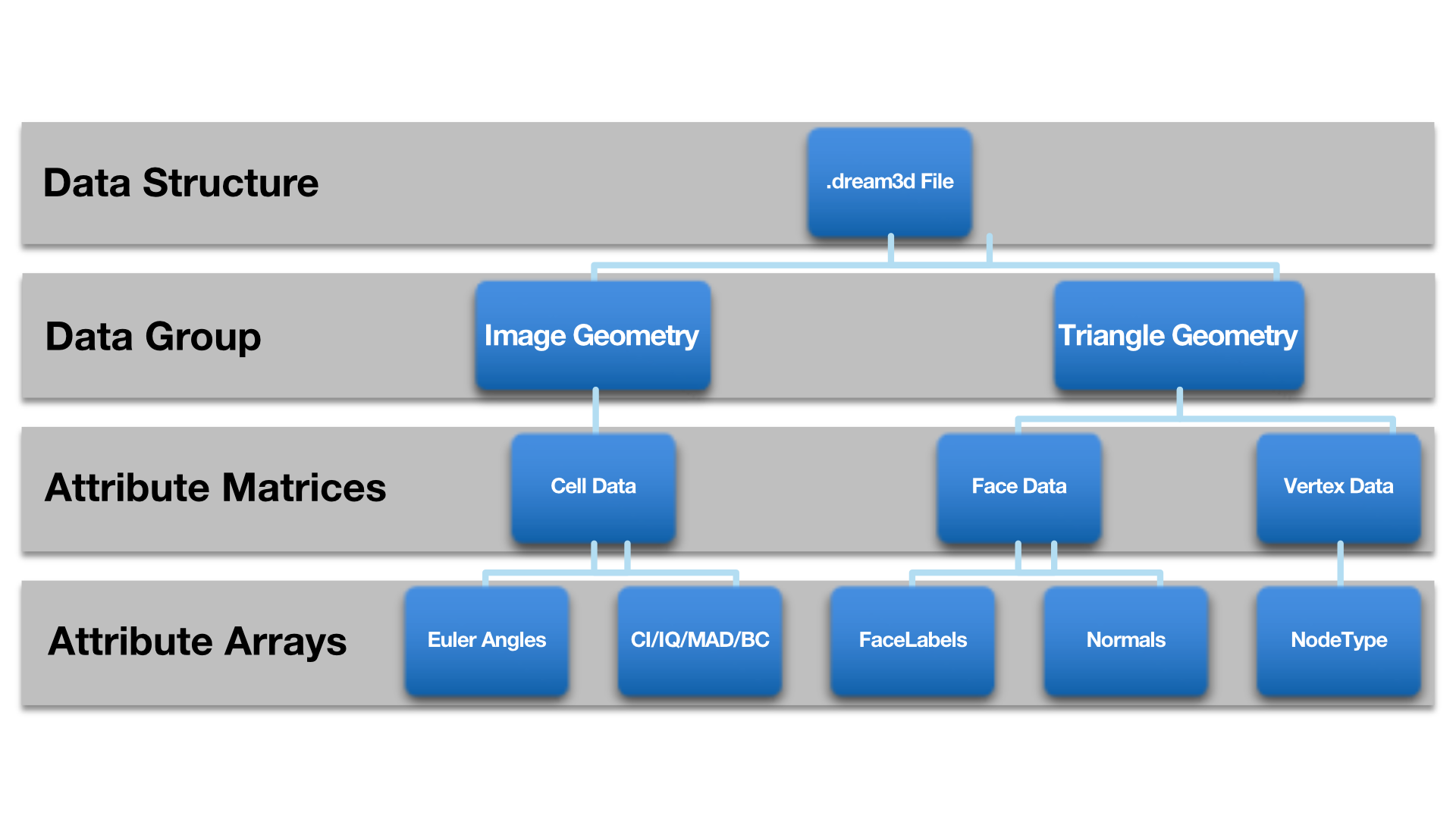
DREAM3D-NX Data Structure
Geometry
A special kind of DataGroup is known as the Geometry, which defines the spatial organization of the data. The Data Container objects are responsible for holding Geometries. In general, this means that the distinguishing characteristic between two Data Containers is their associated Geometry objects. Geometries are generally classified by the topology of their unit Element, which is the smallest building block of the geometry. Elements can have 4 different dimensions: 0 (points), 1 (lines), 2 (polygons), and 3 (polyhedra). In the DREAM3D-NX ontology, these are generally referred to as Vertices, Edges, Faces, and Cells.
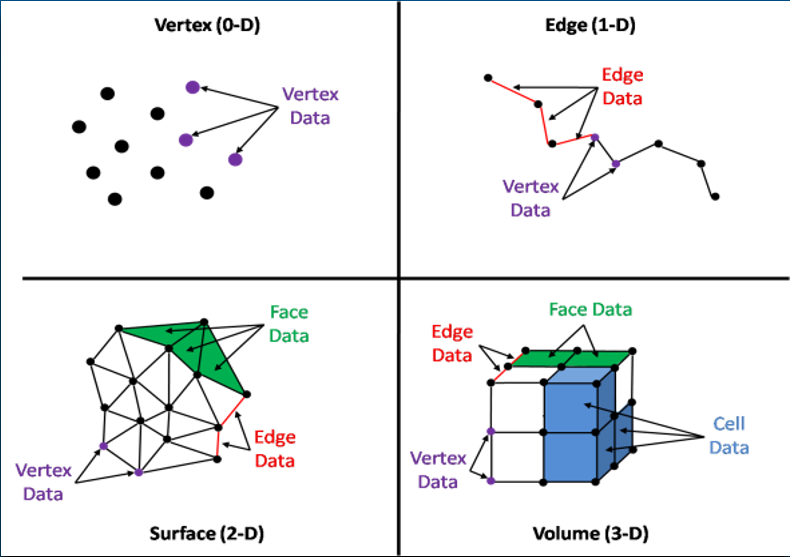
Unit Element Types
Data attributes can be associated with any of these element types, as long as that association makes sense for the given element topology. For example, a triangulated surface mesh can have Vertex, Edge, and Face data associated with it, but not Cell data, since a triangle has a 2-dimensional topology. To help the user keep track of the Geometry type associated with a particular Data Container, DREAM3D-NX sets default names of Data Containers to be prefixed with the Geometry type when applicable. For example, a Data Container containing an Image Geometry would have a default name ImageDataContainer. Of course, you can rename Data Containers if you prefer a different data scheme.
Currently Implemented Geometries
Name |
Topology |
Associated Data |
Description |
|---|---|---|---|
Vertex |
0 |
Vertex |
A collection of points, commonly referred to as a point cloud |
Edge |
1 |
Edge/Vertex |
A collection of edges defined by two vertices, forming lines |
Triangle |
2 |
Face/Edge/Vertex |
A collection of triangles; one type of surface mesh |
Quad |
2 |
Face/Edge/Vertex |
A collection of quadrilaterals; one type of surface mesh |
Image |
3 |
Cell |
A structured, rectilinear grid; this Geometry is composed of pixels (in 2D) or voxels (in 3D) with constant resolution |
RectGrid |
3 |
Cell |
An unstructured, rectilinear grid; this Geometry is composed of pixels (in 2D) or voxels (in 3D) with variable resolution |
Tetrahedral |
3 |
Cell |
A collection of tetrahedra; one type of volume mesh |
Hexahedron |
3 |
Cell |
A collection of hexahedra; one type of volume mesh |
Attribute Matrices & Data Hierarchy
Data is organized in DREAM3D-NX using Attribute Matrix or DataGroups objects. These objects themselves do not store data; instead, they store Data Arrays, which are the low-level containers for contiguous regions of data. There are a variety of different types of Attribute Matrices:
Element: Attribute data associated directly with the features of the Geometry objects. Types of Element Attribute Matrices include:
Vertex: Attribute data associated with vertices
Edge: Attribute data associated with edges
Face: Attribute data associated with polygons
Cell: Attribute data associated with polyhedra
Feature: Attribute data associated with collections of Elements
Ensemble: Attribute data associated with collections of Features
The four different types of Element Attribute Matrix correspond to the four possible levels of dimensional topology for a given Geometry. For example, a Triangle Geometry may have a Vertex Attribute Matrix that stores an Attribute Array that defines a scalar at each vertex, and a Face Attribute Matrix that defines a vector on every triangle. This example points out one of the advantages of the DREAM3D-NX data structure: data with any amount of dimensionality can be stored efficiently thanks to the generic object-attribute associations. Note as well that the Attribute Matrix itself defines the tuple dimensions for a given kind of data, whereas the Data Arrays in that Attribute Matrix define the component dimensions of the raw data. For example, consider a Triangle Geometry with 20 triangles. A Face Attribute Matrix for this Geometry will have 20 tuples; i.e., the number of triangles. An associated scalar Attribute Array in this Face Attribute Matrix will also have a tuple length of 20, since 20 x 1 = 20. But an Attribute Array that defines a vector (such as a normal for each triangle) would have 3 components. This vector array is still associated with the triangles, so it is stored in the Face Attribute Matrix. The total number of elements for the underlying array in this case is now 60, since 20 x 3 = 60.
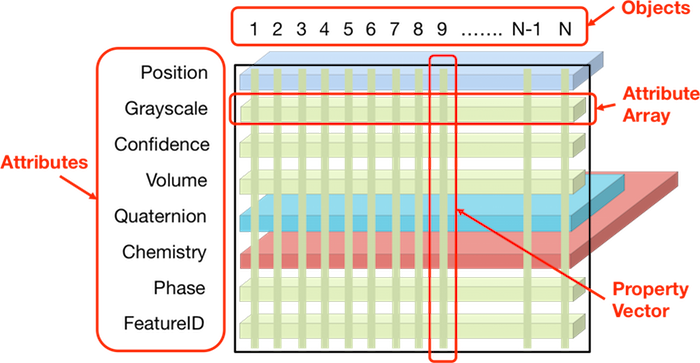
Attribute Matrix Layout
A given Data Container should only have at most one type of each of the different varieties of Element Attribute Matrix. This arises because a given Geometry should only have one way to organize its unit elements in space (e.g., the number of triangles in a Triangle Geometry remains fixed). If the number of any components in a Geometry change, then that defines a new Geometry that should belong in a new Data Container with new associated Attribute Matrices. Note that if the elements of a Geometry merely move (e.g., via a mesh smoothing process), then there is no need to instantiate new Attribute Matrices, since the underlying tuple dimensions have remained constant.
The underlying Elements of a given Geometry can be grouped together to form collections of Elements via some classification rule. A common example is segmenting a grayscale image by assigning all pixels with less than a certain grayscale value to class 1, and all others to class 2. This procedure introduces a sense of hierarchy to a data stream. DREAM3D-NX refers to these collections of Elements as Features. These Features can then have data associated with them through a Feature Attribute Matrix. Any kind of Element may be grouped into Features, thus there are many ways to group said Elements. Therefore, Data Containers can generally contain as many Feature Attribute Matrices as are necessary. To continue the hierarchy scale, DREAM3D-NX allows for Features to be grouped together to form Ensembles. Again, these Ensembles can have associated Ensemble Attribute Matrices to store data, and there may be many Ensemble Attribute Matrices in a given Data Container. In principle, it is even possible to have Ensembles of Ensembles! In this manner, the DREAM3D-NX data structure allows data associations to bridge across multiple length scales.
Both Features and Ensembles must be made up of some specific Element type at the lowest level. DREAM3D-NX currently requires that any set of Features (and thus Ensembles as well) must be composed of the same unit Element type. For example, Features can be made up of a collection of Triangles, but not both Edges and Triangles. Of course, it is possible to have a set of Features made up of Edges only and a set of Features made up of Triangles only within the same Triangle Geometry. To help the user keep track of these distinctions, DREAM3D-NX names Feature/Ensemble Attribute Matrices with a prefix that identifies the unit Element building block by default. For example, a set of Features made up of Cells would have a default Attribute Matrix name of CellFeatureData. Of course, you can rename Attribute Matrices if you prefer a different data scheme.
A key concept behind Features and Ensembles is the existence of a map that ties the entries in a Feature/Ensemble Attribute Matrix to one level lower in the hierarchy. The values in this map are commonly referred to as Ids. For example, consider an Image Geometry in 2D that has a set of 10 Features within it, defined by 10 groups of pixels. The Attribute Matrix associated with this set of Features will have 11 tuples. Why 11 and not 10? DREAM3D-NX begins numbering Features and Ensembles at 1, and reserves the 0 value for special use. Therefore, the number of tuples for a given Feature/Ensemble Attribute Matrix is always one larger than the actual number of Features/Ensembles. Since the Features are groups of pixels (a kind of Element), DREAM3D-NX associates each pixel with a particular Feature. These Feature Id values correspond to integers that sit on the pixel Elements, and allow DREAM3D-NX to index into the Feature Attribute Matrix by knowing the Feature Id at one level lower in the hierarchy. The same concept applies to Ensemble Ids sitting at the Feature level. These map associations enable DREAM3D-NX to efficiently link between the various hierarchy scales, allowing for connections and correlations to be assessed.
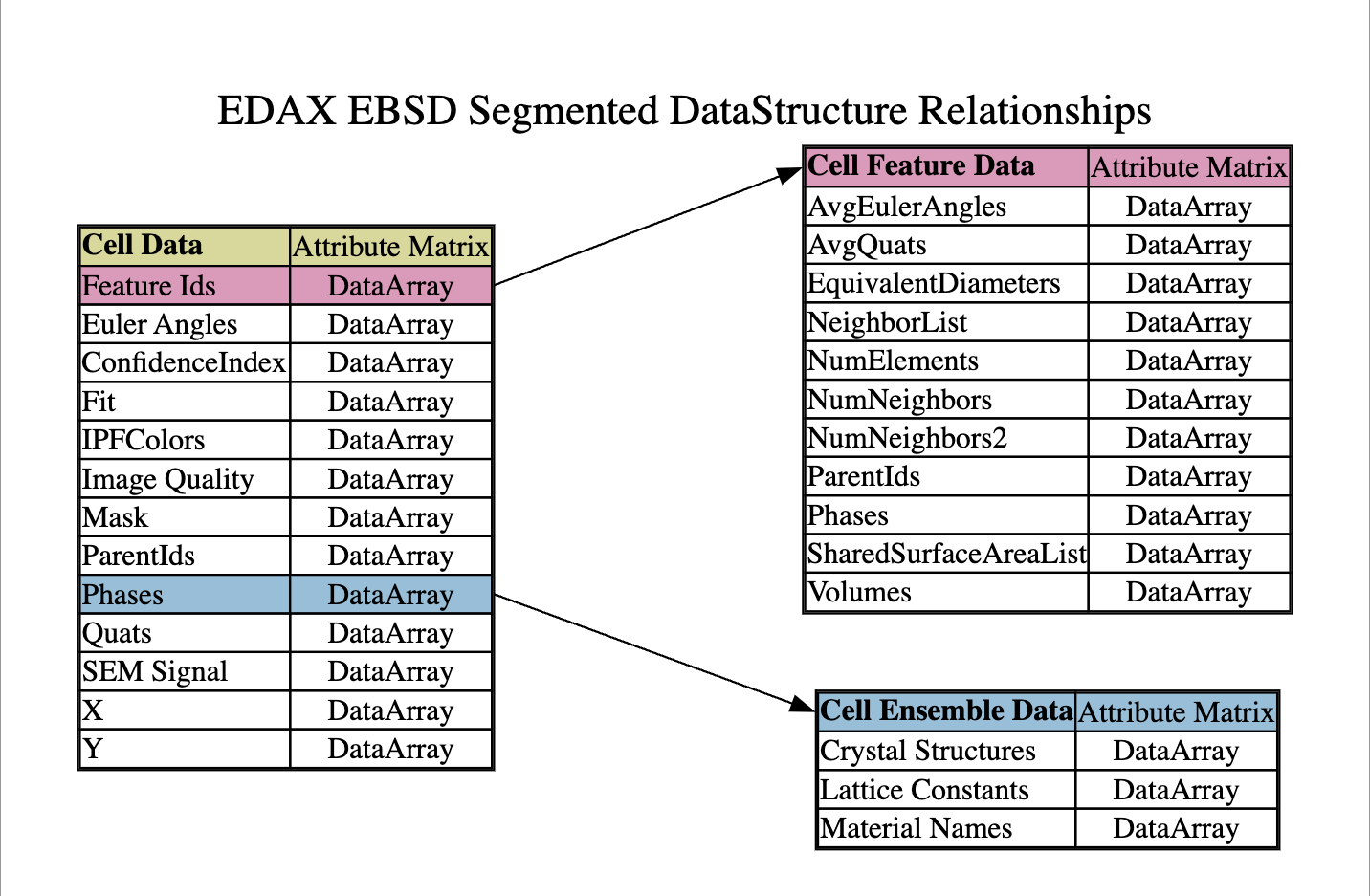
Mapping between AttributeMatrix using Cell Data “FeatureIds” to link to the feature data and Cell Data “Phases” to link to the Ensemble Data
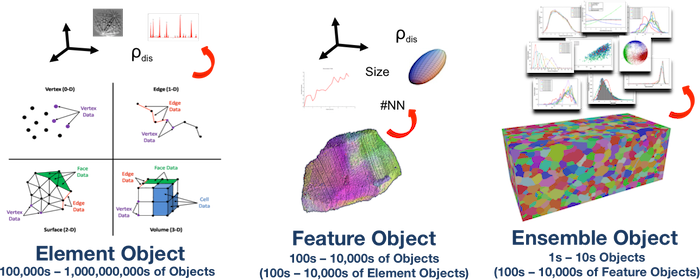
Object-Attribute Associations
For a detailed discussion of the DREAM3D-NX data structure and its associated applications to the analysis of microstructure data, please consult this IMMI paper.
Filter
Manipulation of the underlying data structure is exposed to the user through the use of Filters. A Filter can be considered a self-contained function, which takes the existing data structure as input and performs some series of operations to modify the data structure and produce and output. Filters can be strung together to form a Pipeline, in which the data structure flows through the set of Filters, being modified along the way. If a Filter reads in data from outside of DREAM3D-NX, then the new data will be incorporated into the existing data structure. Or, if no data structure yet exists (e.g, starting from a “blank slate”), a new one will be created.
- class simplnx.IFilter
This class holds an instantiation of a DREAM3D-NX filter. The filter can be preflighted, executed or just held for later execution.
- name()
- Returns:
The C++ classname of the filter
- Return type:
str
- human_name()
- Returns:
What the user would see in the DREAM3D-NX application
- Return type:
str
- uuid()
- Returns:
The unique identifier of the filter
- Return type:
str
- execute()
- Returns:
A complex.IFilter.Result object that contains any warnings or errors that were encountered during the execution of the filter.
- Return type:
complex.IFilter.Result
- preflight()
- Returns:
A complex.IFilter.Result object that contains any warnings or errors that were encountered during the preflight of the filter.
- Return type:
complex.IFilter.Result
create_array_filter = nx.CreateDataArrayFilter()
print(f'{create_array_filter.name()}')
print(f'{create_array_filter.human_name()}')
print(f'{create_array_filter.uuid()}')
For examles of executing a filter, please see any of the example python files included with the source package.
Pipelines
Filters in DREAM3D-NX are contained within Plugins, which are collections of Filters with similar scope. The Plugin itself is the actual library into which the Filters are compiled. The Filters’ are listed in the interface alphabetically by their name, and may not correspond to their actual Plugin library. For more information about how to find Filters in the interface, see the Filter List View section.